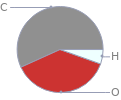Input interpretation

1, 2-di-o-sinapoyl-beta-D-glucose | elemental composition
Result

Find the elemental composition for 1, 2-di-o-sinapoyl-beta-D-glucose in terms of the atom and mass percents: atom percent = N_i/N_atoms × 100% mass percent = (N_im_i)/m × 100% Plan: • Write the chemical formula and gather atomic masses from the periodic table. • Determine values for N_i, m_i, N_atoms and m using these items. • Finally, compute the percents and check the results. Write the chemical formula: C_28H_32O_14 Use the chemical formula to count the number of atoms, N_i, for each element and find the total number of atoms, N_atoms, per molecule: | number of atoms C (carbon) | 28 H (hydrogen) | 32 O (oxygen) | 14 N_atoms = 28 + 32 + 14 = 74 Divide each N_i by N_atoms to calculate atom fractions. Then use the property that atom fractions must sum to one to check the work: | number of atoms | atom fraction C (carbon) | 28 | 28/74 H (hydrogen) | 32 | 32/74 O (oxygen) | 14 | 14/74 Check: 28/74 + 32/74 + 14/74 = 1 Compute atom percents using the atom fractions: | number of atoms | atom percent C (carbon) | 28 | 28/74 × 100% = 37.8% H (hydrogen) | 32 | 32/74 × 100% = 43.2% O (oxygen) | 14 | 14/74 × 100% = 18.9% Look up the atomic mass, m_i, in unified atomic mass units, u, for each element in the periodic table: | number of atoms | atom percent | atomic mass/u C (carbon) | 28 | 37.8% | 12.011 H (hydrogen) | 32 | 43.2% | 1.008 O (oxygen) | 14 | 18.9% | 15.999 Multiply N_i by m_i to compute the mass for each element. Then sum those values to compute the molecular mass, m: | number of atoms | atom percent | atomic mass/u | mass/u C (carbon) | 28 | 37.8% | 12.011 | 28 × 12.011 = 336.308 H (hydrogen) | 32 | 43.2% | 1.008 | 32 × 1.008 = 32.256 O (oxygen) | 14 | 18.9% | 15.999 | 14 × 15.999 = 223.986 m = 336.308 u + 32.256 u + 223.986 u = 592.550 u Divide the mass for each element by m to calculate mass fractions. Then use the property that mass fractions must sum to one to check the work: | number of atoms | atom percent | mass fraction C (carbon) | 28 | 37.8% | 336.308/592.550 H (hydrogen) | 32 | 43.2% | 32.256/592.550 O (oxygen) | 14 | 18.9% | 223.986/592.550 Check: 336.308/592.550 + 32.256/592.550 + 223.986/592.550 = 1 Compute mass percents using the mass fractions: Answer: | | | number of atoms | atom percent | mass percent C (carbon) | 28 | 37.8% | 336.308/592.550 × 100% = 56.76% H (hydrogen) | 32 | 43.2% | 32.256/592.550 × 100% = 5.444% O (oxygen) | 14 | 18.9% | 223.986/592.550 × 100% = 37.80%
Mass fraction pie chart

Mass fraction pie chart